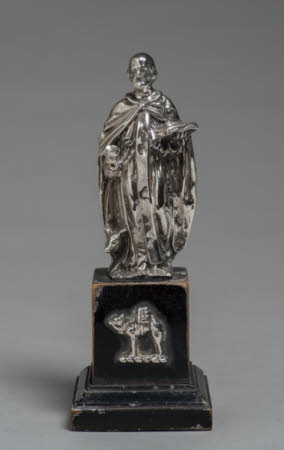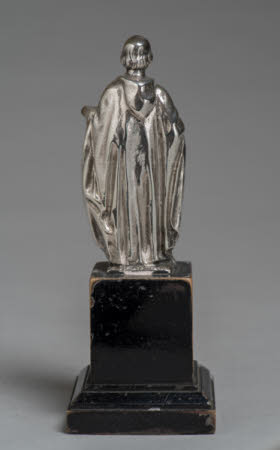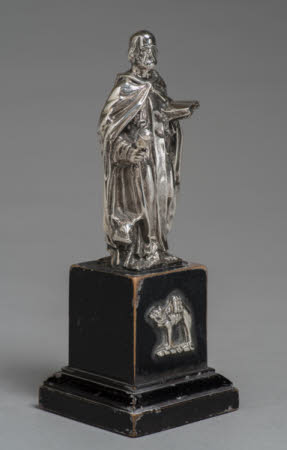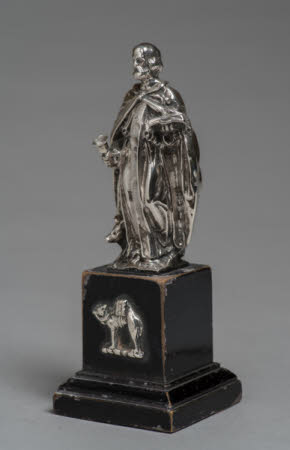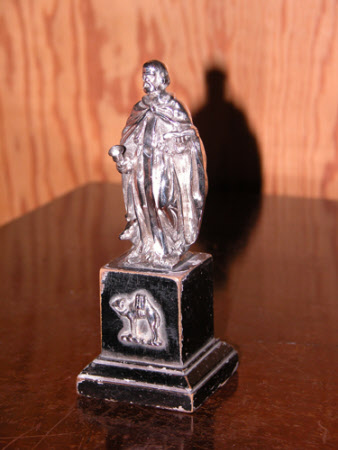Saint Anthony Abbot
John Bodman Carrington (1843 - 1926)
Category
Art / Sculpture
Date
1903 - 1904
Materials
Silver
Measurements
834 x 364 x 293 mm
Place of origin
London
Order this imageCollection
Anglesey Abbey, Cambridgeshire
NT 517635
Summary
Silver, statuette of Saint Anthony Abbot, John Bodman Carrington (1843-1926), 1903-4. A silver statuette of Saint Anthony Abbot, by John Bodman Carrington (active from 1873, died 1926). The saint is robed in vestments, including a cope fastened at the neck, in his right hand a bell, in his left hand an open book. Peeking out from under the cope at right is a hog. The integral rectangular base marked for John Bodman Carrington, and dated 1903-04. On an ebonised wooden base with, set into the centre front, a silver relief of a camel bearing a load.
Full description
The little figure is identifiable as Saint Anthony Abbot from the bell that he holds and the little pig, which peeks out from the underside of his cloak. Anthony the Great or Anthony Abbot (?251-356 A.D.) was a saint and hermit born in upper Egypt who, on the death of his parents, distributed all his property and retired to the desert where he lived in solitude as a hermit for many years, becoming known as the father of monasticism. In around 1095 the Order of the Hospital Brothers of Saint Anthony was founded, which became a major Hospitaller order in the course of the subsequent centuries, with hospitals across Europe. Saint Anthony was invoked in particular for protection against the disease of ergotism, also known as Saint Anthony’s Fire, a convulsive affliction caused by eating a fungus that can grow on grain products. The hospitallers wore black robes embellished with a blue Tau-cross and would carry little bells which they would ring, when seeking alms. These bells would then be hung round the necks of animals in order to safeguard them against disease. One of the special privileges of the Order was that its pigs were allowed to roam freely in the streets. Thus, the iconography of Saint Antony commonly shows him dressed in monk’s robes, holding a stick (absent in this statuette), a bell and accompanied by a pig. The bell, an instrument commonly used to drive away temptation, may also refer to the hallucinatory temptations endured by Saint Anthony whilst he spent time as a hermit in the desert. The significance of the little silver relief of a loaded camel on the base of this small devotional statuette is not known. Perhaps it refers to Saint Anthony’s life in the deserts of Egypt. The statuette is marked for John Bodman Carrington (1843-1926), a successful London silversmith in the latter decades of the nineteenth century (for Carrington, see J.D. Culme, The Directory of Gold & Silversmiths, Jewellers and allied Traders 1838-1914, Woodbridge1987, 2 vols., I, p. 75). In 1873 he founded a silversmithing business at 130 Regent Street which in 1880 was re-named Carrington & Co. and became very successful. The firm specialised in extra-strong silver plate for use in restaurants, hotels and ships. By the early 1890s Carrington was advertising itself as jewellers, diamond merchants, dealers in precious stones and manufacturing silversmiths. It was first awarded the Royal Warrant by Queen Victoria, but also gained the warrants of Prince Albert, King Edward VII and King George V, as well as those of Tsar Nicholas I and II and Queen Alexandra of Russia. Works by Bodman Carrington are in the Goldsmiths Company collection, the Royal Collection and the Victoria & Albert Museum. John Bodman Carrngton was an active member of the Goldsmiths’ Company, serving as Prime Warden in 1903/4, the year for which the statuette of Saint Antony Abbot is marked. He was author, with George Ravensworth Hughes, of the first catalogue of the Company’s collections, The Plate of the Worshipful Company of Goldsmiths, Oxford 1926. Jeremy Warren 2019
Provenance
Bequeathed to the National Trust by Huttleston Rogers Broughton, 1st Lord Fairhaven (1896-1966) with the house and the rest of the contents.
Credit line
Anglesey Abbey, The Fairhaven Collection (The National Trust)
Marks and inscriptions
On front of rectangular base: Hall marks JBC in a quatrefoil, for John Bodman Carrington Lion, Leopard’s head and ‘h’ for London mark, 1903-04
Makers and roles
John Bodman Carrington (1843 - 1926), silversmith

